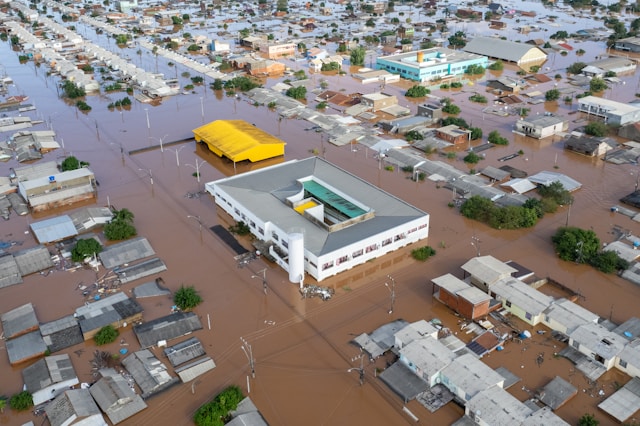‘Social macro’: a new frontier for climate risk

Climate-related social risks lie at the heart of a just transition. Addressing them is increasingly being recognised as a key aspect of climate policy and financial risk management, write Alexander Weston and Judith Tyson.
Climate-related social risks represent a significant challenge to reducing greenhouse gas emissions and delivering an orderly transition. These risks originate from both the physical impacts of climate change and the policy and market changes needed to abate them. They include the well-recognised effects on employment, inflation and household wealth, as well as the often-undervalued consequences for migration, conflict and overall social stability.
Given their growing threat to human welfare as well as the uncertainty they create over policy and economic outlooks, including GDP growth, monetary policy and investment, climate-related social risks warrant greater recognition. Indeed, understanding and managing these social ‘macro’ risks no longer represents a peripheral concern but an important frontier for both policymakers and financial market participants.
Emerging evidence for climate-related social risks
In advanced economies, climate-related inflation and resistance to climate policies are already shaping electoral outcomes. In Europe, European Central Bank (ECB) research has found that the extreme heat of summer 2022 played a contributing role in increasing food price inflation, a development that fuelled the political turmoil associated with the cost-of-living crisis.
More severe impacts, including migration and conflict, are well observed in the African Sahel region, where increasingly frequent and intense climate-related hazards act as a social-risk multiplier by deepening food insecurity and livelihood loss. As noted by the World Bank, in West Africa alone, internal climate migration could reach up to 54.4 million people by 2050.
Despite their growing prevalence, social risk drivers remain insufficiently embedded in climate policy frameworks and investment decision-making. In developing countries, Western responses have historically overweighted security-first approaches while under-addressing the structural social drivers of instability. Meanwhile, capital markets’ low risk appetite for fragile contexts has left climate adaptation finance chronically inadequate. The result is a self-reinforcing risk spiral where underfunded climate adaptation fuels deeper instability, which in turn further constrains investment.
Unequal distribution of risks
Importantly, climate-related social risks are disproportionately concentrated within certain regions, sectors, communities and financial intermediaries, creating correlated risks and the potential for amplification.
The geographical concentration of physical risks is expected to leave certain communities and countries highly exposed, thereby affecting how risks are distributed and absorbed. Large disparities in projected physical-risk damages, at the national and sub-national level, alongside variations in institutional capacity, make spatial concentration a significant determinant of risk heterogeneity.
Developing countries in particular face greater climate risks while also having lower institutional capacity and scarcer financial resources to adapt and build resilience, compared with wealthier nations. They are therefore more likely to experience larger, more persistent, and more pervasive social risks. The Sixth Assessment Report of the Intergovernmental Panel on Climate Change (IPCC) has highlighted that approximately 3.5 billion people are living in contexts that are highly vulnerable to climate change, with global ‘hotspots’ found across Africa, Asia, Central and South America and Small Island Developing States. The resulting loss and damage are thus unequally distributed: the same IPCC report finds that between 2010 and 2020 mortality from floods, droughts and storms was approximately 15 times higher in highly vulnerable regions than in regions with very low vulnerability.
But concentrated risks are not restricted to developing countries. Within advanced economies, riverine flooding, set to be the most economically damaging and widespread physical risk in the EU over the next two decades, is concentrated within regions where large shares of economic activity and bank lending are located. The macroeconomic significance is already visible, with research conducted by the ECB showing that riverine floods caused €7.8 billion in annual damages in the EU and the UK in 2020, and affects more than 170,000 people each year. Without further adaptation, losses could escalate to €50 billion annually by 2100 under 3°C of warming.
Social risks and their associated costs also fall disproportionately on low-income households, raising tensions that can affect the political consensus on climate action. Given that poorer households devote a larger share of their income to essentials, especially food and energy, increases in prices driven by climate change translate into outsized real-income losses and insecurity. At the same time, these populations face higher exposure to climate-related health risks while lacking the wealth needed to cushion such losses.
Labour-market exposures likewise compound these risks. Workers displaced from fossil fuel and heavy-manufacturing sectors face larger and more persistent earning losses relative to other sectors, reflecting older age profiles, lower-level transferable skills and loss of firm premia, and are often concentrated within certain geographical areas. Evidence from Autor et al. on the ‘China shock’ – the global manufacturing surge following China’s transition to a market-oriented economy and accession to the World Trade Organization – suggests such labour displacement could be persistent, depressing local activity and incomes, raising demand for public transfers and intensifying political polarisation.
Indeed, the unequal exposure to both the physical risks and transition costs of climate change creates potential for social instability, whether that be through the direct physical impacts or backlash against transition measures that are truly unjust or perceived as such.
Challenges to economic and financial stability
Research on climate-related social risks to stability has predominantly focused on the effects and distribution of inflation and employment. A distinct social dimension that encompasses further factors such as migration, conflict and political instability has largely been absent – despite these hazards being well recognised in risk management and the presence of clear evidence that climate change amplifies them.
These risks could have widespread implications for the performance and volatility of key asset classes, including fixed income, equities, commodities and foreign exchange. For example, in emerging economies, where vulnerability to physical hazards is greater and institutional capacity weaker than in wealthier nations, climate-related social shocks may prompt capital outflows or deter foreign investment, placing considerable strain on external financing needs. If foreign exchange reserves become depleted, these pressures can escalate, heightening the risk of financial and economic instability.
Concentrated exposure to climate-related social risks among financial institutions heightens concerns for macroeconomic stability. This threat becomes more severe when banks and investment funds with large exposures to climate-vulnerable assets underestimate the social channels through which losses arise. An exemplary case can be made through concentrated lending within regions reliant on climate-vulnerable sectors such as fossil fuels, hard-to-abate industries or agriculture, where first-order physical and transition risk may be compounded through subsequent persistent employment shocks, falling incomes and resulting credit strain. Over time, these pressures may contribute to amplifying risks for financial intermediaries whose portfolios lack relevant diversification.
Yet despite such potential consequences, the limited availability of research and risk management instruments, such as climate derivatives, leaves important questions about their capacity to generate significant market disruption and financial instability.
Existing assessments and frameworks remain inadequate – more research is needed
Central banks and other financial institutions have sought to integrate climate change into their frameworks over the past decade, often mapping climate drivers onto already existing and familiar categories such as credit, market and liquidity risk. Indeed, the significance of conceptualising climate risk within established frameworks cannot be understated, not only providing the analytical toolkit, but also facilitating the assimilation of climate risk by lending familiarity and legitimacy for diverse stakeholders.
At the same time, the idiosyncratic properties of climate risk, including long time horizons, deep uncertainty and non-linearity, have exposed the limits of conventional approaches and led to the development of novel tools, such as forward-looking climate scenario analysis. More recently, central banks and other related institutions have acknowledged that even these are insufficient on their own. Fully grappling with climate-related risk requires going beyond modelling to incorporate a broader understanding of how climate change interacts with social, financial and economic channels and generates feedback effects between them. Social risks offer one such frontier of inquiry, providing both policymakers and financial market participants with the necessary research and heuristics needed for effective risk management.
By placing social risks at the centre of our analysis at the Just Transition Finance Lab, we seek to contribute to addressing the challenge of conceptualising a ‘just transition’. Recognising that the notion of justice inevitably raises normative questions that are difficult to resolve, our work aims to provide rigorous research on where social risks are most acute, how they are likely to be distributed, and what their implications may be, in the hope of advancing our collective navigation of these issues.




